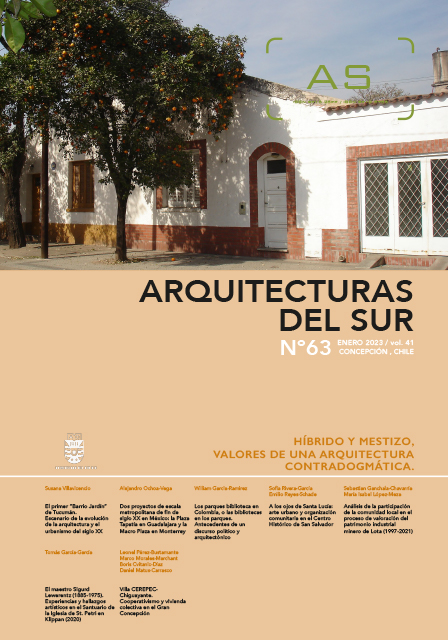Two Mexican metropolitan-scale projects at the end of the 20th century - Plaza Tapatía in Guadalajara and Macro Plaza in Monterrey
DOI:
https://doi.org/10.22320/07196466.2023.41.063.02Keywords:
urban planning, architecture, historic centers, modernityAbstract
This article analyzes the experiences of two projects which had a major urban impact in the 1980s on two Mexican cities, Guadalajara and Monterrey. In both cases, the background behind urban planning and the different projects to regenerate the historic city centers are discussed. The considerations of the local authorities regarding the tired and deteriorated image of the old downtown area are also presented, outlining the large-scale interventions that involved the demolition of colonial and 19th-century buildings and spaces. The results are contradictory: on one hand, a large public space was gained, but at the same time, the original city layout and many heritage buildings were lost. Both projects were the result of authoritarian political decisions, by governor decrees, without any consultation with the inhabitants of Guadalajara and Monterrey.
Downloads
References
AGUILAR CAMÍN H. y MEYER L. (2008). A la sombra de la Revolución Mexicana. México: Cal y Arena.
BULNES, O. (2006). Entrevista realizada por Alejandro Ochoa [comunicación personal]. 29 de julio de 2006.
CRESWELL, J. (2007). Qualitative inquiry & research design. California: SAGE.
DÍAZ- BERRIO, S. (1970). Guadalajara, ciudad crucificada. Revista Universidad de Guanajuato, (27), 70-82.
ELIZONDO, J. G. (1979). Guadalajara está en marcha. Obras, (28), 13.
GONZÁLEZ ROMERO, D. (1987) El Posmoderno en América Latina: el caso de la Plaza Tapatía en Guadalajara, México. En: A. Fernández Alba, D. González Romero, R. López Rangel, I. Solá-Morales, E. Subirats y A. Toca Fernández, Más allá del Posmoderno, crítica a la arquitectura reciente (pp. 40-56). México: Gustavo Gili.
HERNÁNDEZ LARRAÑAGA, J. (2001). Guadalajara: identidad perdida. Transformación urbana en el siglo XX. Guadalajara: Ágata.
KASIS, A. (2004). Ignacio Díaz Morales. Monografías de Arquitectos del Siglo XX, (1), 54-63.
MARTÍNEZ, E. (1999). Encuentro con el Barrio Antiguo de Monterrey. Monterrey: Universidad Autónoma de Nuevo León, Ayuntamiento de la Ciudad de Monterrey.
MONTERO, C. (2002). La renovación urbana, Puebla y Guadalajara: un estudio comparado. Puebla: Benemérita Universidad Autónoma de Puebla, Instituto de Ciencias Sociales y Humanidades.
NÚÑEz, B. (1999). Guadalajara una visión del siglo XX. Guadalajara: El Colegio de Jalisco y Ayuntamiento constitucional de Guadalajara.
Plan Nacional de Desarrollo Urbano (1978). Plan Nacional de Desarrollo Urbano 1978. Diario Oficial de la Federación. Recuperado de: http://dof.gob.mx/nota_detalle.php?codigo=4708002&fecha=12/06/1978#gsc.tab=0
PLIEGO, J. (2006). Entrevista realizada por Alejandro Ochoa [comunicación personal]. 25 de Julio de 2006.
VÁZQUEZ, D. (1989). Guadalajara: ensayos de interpretación. Guadalajara: Colegio de Jalisco.
ZAMBRANO, F. (2003). La polisemia del espacio público. En Bogotá y lo público. Colección Construcción de lo público, (1), (pp. 35-46). Bogotá: Universidad de los Andes.
Downloads
Published
How to Cite
Issue
Section
License
Copyright (c) 2023 Alejandro Ochoa-Vega

This work is licensed under a Creative Commons Attribution-ShareAlike 4.0 International License.
The content of the articles published in each issue of Arquitecturas del Sur is the sole responsibility of the authors and does not necessarily represent the opinion of University of the Bío-Bío.
The authors will maintain their copyright; however, they will guarantee the journal the right to first publication and dissemination of their work. The publication of the article in Arquitecturas del Sur will be subject to the Creative Commons International license (CC BY-SA) that allows others to adapt: remix, transform and build on the material for any purpose, even commercially; share: copy and redistribute the material in any medium or format, as long as the authorship and first publication in this journal are acknowledged by citing them correctly, and their new contributions are under a license with the same terms.














 Programa de Información Científica/Concurso Fondos de Publicación de Revistas Científicas 2018/ Proyecto Mejoramiento de Visibilidad de Revistas UBB (Código:FP180007)
Programa de Información Científica/Concurso Fondos de Publicación de Revistas Científicas 2018/ Proyecto Mejoramiento de Visibilidad de Revistas UBB (Código:FP180007) 
